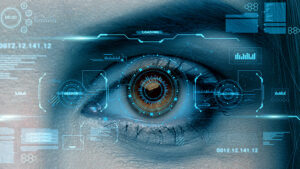February 15, 2024
By Dwight Akerman, OD, MBA, FAAO, FBCLA, FIACLE
The use of low-level red light (LLRL) therapy has gained popularity as a treatment for myopia in children, especially in China. However, concerns have been raised about the safety of these devices, as their output may exceed the recommended safety limits. A recent study conducted by Lisa Ostrin and Alexander Schill aimed to characterize the output of two LLRL devices and determine their thermal and photochemical maximum permissible exposure (MPE) for myopia control.
The study examined two LLRL devices — the Sky-n1201a and the Future Vision — and measured their optical power using an integrating sphere radiometer through a 7-mm diameter aperture. The retinal spot sizes of the devices were obtained using a model eye and high-resolution beam profiler. The corneal irradiance, retinal irradiance, and MPE were then calculated for an eye positioned at the oculars of each device.
The findings of the study showed that both devices were confirmed to be Class 1 laser products. The Sky-n1201a delivered laser light as a point source with a 654-nm wavelength, 0.2 mW power (Ø 7 mm aperture, 10-cm distance), 1.17 mW/cm2 corneal irradiance, and 7.2 W/cm2 retinal irradiance (Ø 2 mm pupil). The MPE for photochemical damage is 0.55-7.0 s for 2-7 mm pupils and for thermal damage is 0.41-10 s for 4.25-7 mm pupils. Future Vision delivered the laser as an extended source subtending 0.75 × 0.325°. It has a 652-nm wavelength, 0.06 mW power (Ø 7 mm aperture, 10 cm distance), 0.624 mW/cm2 corneal irradiance, and 0.08 W/cm2 retinal irradiance (Ø 2 mm pupil). The MPE for photochemical damage is 50-625 s for 2-7 mm pupils.
The study revealed that for both LLRL devices, continuous viewing for three minutes or more approached or surpassed the MPE, putting the retina at risk of photochemical and thermal damage. The results of the study suggest that clinicians should be cautious about the use of LLRL therapy for myopia in children until safety standards can be confirmed.
The findings of this study are significant as they highlight the potential risks associated with the use of LLRL devices for myopia treatment in children. While previous studies have reported significant reductions in axial elongation and myopia progression with the use of LLRL therapy, the safety of these devices has yet to be thoroughly evaluated. The results of this study suggest that LLRL devices may exceed the recommended safety limits and that caution should be exercised when using them for myopia treatment.
The study also emphasizes the need for further research to determine the safety and efficacy of LLRL therapy for myopia treatment. As myopia is a widespread condition that affects millions of children worldwide, there is a pressing need to find safe and effective treatment options. While LLRL therapy has shown promise as a potential treatment option, it is vital to ensure its safety before it can be widely adopted as a treatment for myopia.
In conclusion, the study conducted by Ostrin and Schill highlights the potential safety concerns associated with using LLRL devices for myopia treatment in children. The study’s findings suggest that LLRL devices may exceed the recommended safety limits, and caution should be exercised when using them for myopia treatment. The study underscores the need for further research to determine the safety and efficacy of LLRL therapy for myopia treatment, as well as the need to establish safety standards for these devices.
Abstract
Red Light Instruments for Myopia Exceed Safety Limits
Lisa A Ostrin , Alexander W Schill
Purpose: Low-level red light (LLRL) therapy has recently emerged as a myopia treatment in children, with several studies reporting significant reduction in axial elongation and myopia progression. The goal of this study was to characterize the output and determine the thermal and photochemical maximum permissible exposure (MPE) of LLRL devices for myopia control.
Methods: Two LLRL devices, a Sky-n1201a and a Future Vision, were examined. Optical power measurements were made using an integrating sphere radiometer through a 7-mm diameter aperture, in accordance with ANSI Z136.1-2014, sections 3.2.3-3.2.4. Retinal spot sizes of the devices were obtained using a model eye and high-resolution beam profiler. Corneal irradiance, retinal irradiance, and MPE were calculated for an eye positioned at the oculars of each device.
Results: Both devices were confirmed to be Class 1 laser products. Findings showed that the Sky-n1201a delivers laser light as a point source with a 654-nm wavelength, 0.2 mW power (Ø 7 mm aperture, 10-cm distance), 1.17 mW/cm2 corneal irradiance and 7.2 W/cm2 retinal irradiance (Ø 2 mm pupil). The MPE for photochemical damage is 0.55-7.0 s for 2-7 mm pupils and for thermal damage is 0.41-10 s for 4.25-7 mm pupils. Future Vision delivers the laser as an extended source subtending 0.75 × 0.325°. It has a 652-nm wavelength, 0.06 mW power (Ø 7 mm aperture, 10 cm distance), 0.624 mW/cm2 corneal irradiance and 0.08 W/cm2 retinal irradiance (Ø 2 mm pupil). MPE for photochemical damage is 50-625 s for 2-7 mm pupils.
Discussion: For both of the LLRL devices evaluated here, 3 min of continuous viewing approached or surpassed the MPE, putting the retina at risk of photochemical and thermal damage. Clinicians should be cautious with the use of LLRL therapy for myopia in children until safety standards can be confirmed.
Ostrin, L. A., & Schill, A. W. (2024). Red light instruments for myopia exceed safety limits. Ophthalmic and Physiological Optics. Jan 5. Epub ahead of print.
DOI: https://doi.org/10.1111/opo.13272














